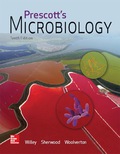
Examine the structures of macromolecules in appendix I. Which type has the most electrons to donate? Suggest why carbohydrates are usually the primary source of energy for bacteria that use organic molecules as energy sources?
To determine: The type of macromolecule that has the most electrons to donate.
Introduction: All living organisms have organic molecules and macromolecules. These may be carbohydrates, lipids, proteins or nucleic acids. Macromolecules are large molecules that are commonly formed by the polymerization of subunits.
Explanation of Solution
Carbohydrates consist of many carbon-hydrogen (C-H) and carbon-carbon (C-C) bonds. These bonds are the source of electrons. Thus, in comparison to other macromolecules such as proteins, lipids, and nucleic acid carbohydrates have more electrons to donate.
To determine: The reason that why carbohydrates are usually the primary source of energy for bacteria that use organic molecules as energy sources.
Introduction: All living organisms have organic molecules and macromolecules. These may be carbohydrates, lipids, proteins or nucleic acids. Macromolecules are large molecules that are commonly formed by the polymerization of subunits.
Explanation of Solution
Chemoautotrophic bacteria depend on organic sources such as sugar, fat, carbohydrate and proteins to obtain electrons and carbon. However, carbohydrates are the macromolecules that act as a large source of electrons. That is why they are used by bacteria as the primary source of energy for the cell.
Want to see more full solutions like this?
Chapter 10 Solutions
Prescott's Microbiology
- Match the terms transamination and deamination to the following? A. An amino acid group is removed from an amino acid and donated to a ketogenic acid. B. An ammonium ion is produced C. New amino acids are synthesized from other amino acids D. A ketogenic acid is produced from an amino acidarrow_forwardhow do other monosaccharides metabolized via glycolysis? simple and concise answer pleasearrow_forwardExplain how the body maintains the blood ph in ketoacidosisarrow_forward
- essay of Methane extraction from anaerobic digestion.arrow_forwardDiscuss the metabolism on how ketone bodies, glucose, pentose, albumin, bile and occult blood is formed.arrow_forwardWhat is the significance of the coagulation of egg white to its digestion? Why is alcohol an effective disinfectant against bacteria? In what way can ingestion of heavy metals, such as lead and mercury, be detrimentalto the proteins in your body? Why is egg white used as an antidote for lead and mercury poisoning?arrow_forward
- Carbohydrates and lipids are composed of the same chemical element, but in different proportions. Both are used primarily as energy source for metabolic process. Which type of biomolecule has the higher calorie content per gram? Explain briefly.arrow_forwardExplain the difference between ketogenesis and ketoacidosis.arrow_forwardWrite down the chemical mechanism of HCl formation in the digestive system.arrow_forward
 Human Physiology: From Cells to Systems (MindTap ...BiologyISBN:9781285866932Author:Lauralee SherwoodPublisher:Cengage Learning
Human Physiology: From Cells to Systems (MindTap ...BiologyISBN:9781285866932Author:Lauralee SherwoodPublisher:Cengage Learning

